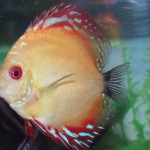If you’ve read many of my website, articles, or emails, you know I always drive home the point that Betta fish deserve bigger tanks than they get in most homes. First of all, let me apologize if I’ve offended you; if you’re in a small apartment, on a tight budget, or had a Betta dropped on you as an unplanned gift, I totally get it. You are not a bad person for having a Betta in a small jar or gallon-sized bowl, that’s not it at all! Having said that, I may still try and convince you, in my own way, to upgrade when you can.
This article will go over the basics of choosing a tank and why different factors like material, size, and ventilation matter. Whether you’ve just gotten a Betta or are thinking about getting one down the road, hopefully this will help you avoid some confusion at the pet store.
Tank Material: To start off, let’s talk tank material. I’m going to be perfectly honest with you, this is not as big of a deal as some people make it out to be. When I was first getting Bettas, I remember a friend saying that the cheesy plastic bowl I had wasn’t going to work because the plastics could negatively affect my Betta’s health. In retrospect, that tank was tiny, ugly, and terrible in a number of ways, but none of them had to do with the plastic. In my experience glass or plastic both work fine. Plastic is lighter but scratches easier and can heat disproportionately in direct sunlight, while glass is more common and more scratch resistant, but is heavy. Nowadays, I just use glass tanks.
Tank Size: As you can imagine, this is a pretty large issue in the Betta community, and it’s debated back and forth fiercely all the time. The general consensus, however, is that bigger is better (to a point). Five gallons in the minimum sized tank a fish should be kept in, with ten gallons being ideal. Having a fish live in a half gallon or one gallon tank is akin to confining a human to a tiny dorm room for the rest of his life (any current or former college student readers should understand how this can get depressing quickly!). Aside from the mental health impacts of a small tank, they rarely get cleaned often enough because they dirty so quickly (every couple of days) and disease and premature death in small tanks is generally a bigger issue than in larger tank environments.
“But, Trent, I’m on a tight budget!”
If this thought springs into your mind, consider the fact that 10 gallons tanks are actually very cheap ($10-20), and many are actually the same price as a smaller model. This is primarily because these are standard size living spaces for many fish and are therefor mass produced easily. If space is a constraint, there may not be much you can do, but please do make an effort to give your little guy or gal the most comfortable living space possible!
Essential Extras: The phrase “essential extras” is kind of an oxymoron, but there are several things you need to have ready at the time of tank setup. These are substrate (rocks for the bottom), decorations (doesn’t have to be extensive), a thermometer, a heater (that has the correct output for your tank size), and chlorine-removal drops to prepare your tap water to house a fish.
















